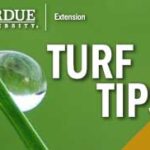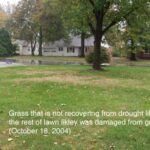Turf Professional
Spring Weed Control or Seeding?
With last year’s late summer and fall drought, many areas are in need of reseeding. The question comes up about seeding and weed control: should the weeds be controlled first or should the seeding be done first? This seems like a simple question, but it’s fairly complex depending on the turf and weed species present […]
Timing of Preemergence Herbicides
If a preemergence herbicide is justified on a turf area, the timing of application is important. In theory, applying too early will expose the herbicide to soil microbes and processes in the soil that may break it down, allowing crabgrass to germinate during the latter part of the summer. Conversely, applying too late may miss […]
Mid-winter Mole Activity
Mole activity is becoming more apparent with the recent warm weather. Large piles of soil on the lawn surface are evidence of the moles subterranean mining. Unfortunately control of this pest still depends on trapping or possibly a mole-hunting cat or dog. Techniques such as drowning with water, poisoning with car exhaust, shocking or vibrating […]
Raffle Winners at Turf Expo
A special thanks goes to the exhibitors who donated raffle prizes for the Turf Expo. Following are the winners of each prize. Exhibitor Prize Winner Aerification Plus Pair of Pacers tickets Feb.16 vs Portland Trailblazers Steve Stringer Aerification Plus Pair of Pacers tickets Mar 31 vs Miami Heat Dave Padgett Ameri-Turf 2-50# bags RTF Tall […]
Thanks for Attending or Helping with Another Successful Midwest Turf Expo
On behalf of the Turf Program and the Midwest Regional Turf Foundation (MRTF), I’d like to thank everyone who helped with and/or attended the 2005 Midwest Turf Expo on January 18-19 at the Indiana Convention Center in Indianapolis . The Expo provides tremendous positive exposure for the Turf Program and the MRTF, and it could […]
There are still openings for the IN-IL Turfgrass Short Course
The IN-IL Turfgrass Short Course will be held on Feb 21-24 in Willowbrook, IL, again this year. This is an outstanding course for new and experienced turf professionals. It’s designed for turf managers with some experience and an understanding of HOW we maintain turf, and meant to improve the understanding of WHY we do the […]
Purdue Alumni and Friends Reception at the GCSAA in Orlando
For those making the trip to Orlando for the GCSAA International Conference and Show, the Purdue Alumni and Friends Reception will be held Thursday, February 10, 6:00 to 8:00 pm in Salon 2 of the Rosen Centre Hotel. It’s a great opportunity to catch up with your classmates and old friends. An autographed Purdue football […]
Dealing With Flood Damage
After widespread flooding, many question how well turf will survive. Turf injury from flooding depends on water temperature, species, duration of submergence, and depth of submergence. Turfgrasses can withstand submersion for up to 60 days when water temperatures are 50 degrees or less. Injury is increased under stagnant water compared to moving water, and injury […]
IN-IL Turfgrass Short Course in February
The IN-IL Turfgrass Short Course will be held on Feb 21-24 in Willowbrook, IL, again this year. This is an outstanding course for new and experienced turf professionals. It’s designed for turf managers with some experience and an understanding of HOW we maintain turf, and meant to improve the understanding of WHY we do the […]
Westin Reservation Date Extended to January 1st!
For those of you still looking for reservations for the Turf Expo, the Westin has extended their cut-off date until Jan. 1. The Westin can be reached at 317-262-8100, and be sure to mention the MRTF to get the reduced $119/night price. The room block reserved for the MRTF is almost sold out (especially on […]
Great Education/Tradeshow at the Turf Expo
The Midwest Turf Expo will be held on January 19-20, 2005 at the Indiana Convention Center in Indianapolis. An outstanding educational schedule compliments a rapidly filling tradeshow held in conjunction with the Indiana Park and Recreation Association. A GCSAA Seminar on understanding soils kicks off the Expo on Tuesday afternoon. Concurrent educational sessions begin on […]
Turf 101: Optimum mowing heights for turf
Below is a table for the optimum mowing heights for turfgrass species in Indiana. The optimum mowing height is where the particular species will perform best, creating the thickest turf, and requiring the fewest inputs. Mowing above these heights will tend to create a less dense turf with coarser leaf blades, and potentially a puffy […]
November Lawn Fertilization
Up until about two weeks ago, autumn 2004 was for the most part a fairly dry season. This means that if you fertilized your cool-season lawn in early September and were unable to regularly irrigate, the nitrogen that was applied probably was not used very effectively by the turfgrass plant. If you missed that fertilizer […]
Controlling Wild Onion or Wild Garlic in Lawns
Wild onion and wild garlic emerging in the southern two-thirds of Indiana and these are difficult-to-control weeds. These weeds look very similar to the garden variety onion except the stems of the wild type are much thinner and do not grow as tall as the garden variety. The most effective method for controlling onion and […]
Keep Mowing to Mulch Those Tree Leaves!
The trees are dropping their leaves and it is important to prevent a heavy layer of leaves from building-up on your turf before winter. Heavy layers of tree leaves that shade the grass can smother and kill grass yet this fall. Plus tree leaf cover favors a damaging winter turf disease called snow mold. The […]
Fertilization required immediately as turf greens-up after rain
Most of the state has received 0.5 inch of rain or more either this week or last and thus turf areas are starting to green-up again. It is important to take advantage of the few weeks of growing conditions and apply fertilizer immediately to help improve green-up, fill-in from drought damage, and winter survival. Apply […]
Grub damage visible as lawns green up
As promised earlier, grub damage is now becoming apparent on lawns that are greening up with the recent rains. Grub damaged turf will not green-up with the rest of the lawn and is likely brown for good (dead) (see accompanying photo). Unfortunately, there’s not much you can do now and insecticides are certainly not effective […]
Options for Seeding Late in the Year
It is now too late to seed a turf area to expect a good stand going into winter. Seeding turfgrasses such as Kentucky bluegrass, perennial ryegrass, or tall fescue during early November may still allow time for germination, but the seedlings are likely to die from winterkill. You currently have 2 viable options: 1. On […]
Controlling broadleaf weeds after the drought
Now that the lawn and weeds have greened-up from the recent rains, broadleaf herbicides should be effective yet this fall. Though these herbicides work faster when the plants are actively growing, these herbicides will still work as long as the plants are green and photosynthesizing. Therefore, applications into November will work, albeit slower. You may […]
Upcoming Open Positions on the MRTF Board of Directors
There will be a number of openings on the MRTF Board of Directors in the upcoming December elections. MRTF’s mission is to support research and education and thus help advance our industry. We are looking for potential board members dedicated to our industry and desiring to help steer the direction of turfgrass research and education. […]

